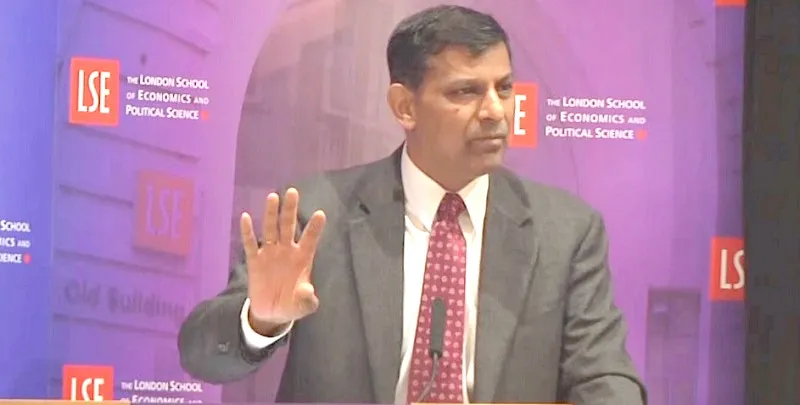Financial inclusion necessary for sustainable growth: Raghuram Rajan
Pitching for financial inclusion, RBI Governor Raghuram Rajan on Monday said that the central bank is trying to make it attractive for institutions to offer banking services to everyone, as it is a necessary building block for sustainable growth.
Observing that bankers usually focus on large borrowers with bottomline in mind, the governor said Aadhaar Enabled Payment System will go a long way in taking financial services to the underserved. Only a month ago, Rajan announced that he's not seeking the second term at RBI Governor and will get back to academia.

Rajan said in an interactive session at the National Institute of Rural Development and Panchayati Raj,
After all, should we not give everyone access to the (banking) services we all in this room enjoy?
Also read: Six memorable speeches by Raghuram Rajan
Stating that imperative for financial inclusion is both, moral as well as one based on economic efficiency, Rajan said if everyone had the tools and resources to better themselves, it would increase output, growth and economic prosperity.
In the foreseeable future, we will bring formal financial services to every Indian who wants them. Financial inclusion will be an important element in ensuring access and equity - the necessary building blocks for sustainable growth of our country.
The country has come a long way in the process of financial inclusion, Rajan said, but added that it "still has a way to go".
Rajan believes that India is steadily moving from mandates, subsidies and reliance on public sector banks for inclusion to creating enabling frameworks that make it attractive for all financial institutions to target the excluded, even while the interests of the excluded are protected through education, competition and regulation.
Easy payments and cash out would make formal savings more attractive and strengthening the network of banking correspondents, creating a registry of banking correspondents, giving them the ability to take and give cash on behalf of any bank through Aadhaar Enabled Payment System would go a long way in reaching financial services to the underserved. Rajan said,
With expanding cash-in, cash-out points through soon-to- be-launched Postal Payment Bank and telecom-affiliated payment banks and making transfers from bank account to bank account easier via mobile through the Unified Payment Interface, we are on the verge of solving the last-mile problem.
Rajan explained economic impediments to greater financial inclusion through the acronym IIT -- information, incentives, and transaction costs. He said the banker, especially if he is not from that region, will have difficulty in getting sufficient information to offer financial products to the excluded.
Also, the lender may not have incentives to lend to the excluded as the legal system does not enforce repayment quickly or cheaply and the borrower does not have any collateral to pledge, he added. The third impediment, Rajan outlined, was transaction costs. Since the size of transactions by the poor, or by micro farmers or enterprises is small, fixed costs in transacting are relatively high.
"If the time and cost involved in filling up a form and documentation for a client, for instance, is the same for a loan of say Rs 10,000 and Rs 10 lakh, a banker who is conscious of the bottomline would naturally focus on the large client," Rajan said.
The RBI governor focussed on three elements of financial inclusion --
- broadening of financial services to those people and enterprises who do not have access to financial services,
- deepening of financial services and,
- greater financial literacy and consumer protection.
Rajan said,
One of the primary motivations for the country to push financial inclusion is to free the excluded from the clutches of the moneylender.
A moneylender does not suffer any of the impediments faced by banks in extending credit to underserved, he said, while proposing three public policy approaches to overcome this:
1. Mandates and subventions: Mandates, Rajan said, are reasonable from a societal perspective but the banks cannot monetise this benefit, only a government can decide to mandate them. There are risks emanating from mandates, he said, adding "narrow targeting of mandates to the truly underserved and explicit payment for fulfilling the mandate are necessary so that they are delivered by the most efficient."
2. Transforming institutions: Another approach, he said, could be transforming institutions. He said local financial institutions, with local control and staffed by knowledgeable local people, could be more effective at providing financial services.
3. Moving away from credit: The third approach, Rajan said, could be to let credit follow not lead. The government and RBI are doing this by encouraging easing of payments and remittances, on expanding remunerative savings vehicles, or on providing easy-to-obtain insurance against crop failures, he said.
Rajan said,
Savings habit, once inculcated, not only allows the customer to handle the burden of repayment better, it may also lead to better credit allocation.
Rajan outlined five issues that arise in managing the process and the RBI was trying to simplify those:
- Know your customer requirements,
- Encouraging competition to prevent exploitation,
- Ensuring some flexibility and forgiveness in financial arrangements,
- The need for skilling,
- Encouraging financial literacy and ensuring consumer protection.







